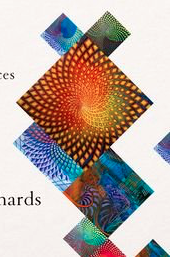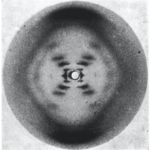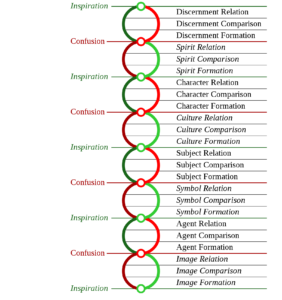
This is the model which is described in the Nutshell section of this website. Click on the image to enlarge it.
This section will delve deeper into the sources and implications of the double helix model. The model can be many things to different people, but one thing it is not, and that is reductionistic. The model cannot be understood or used if it is assumed that life and consciousness can be accounted for with strictly material and mechanistic processes. Many scientists and philosophers have recently concluded that life and consciousness necessarily involve teleological processes which are determined by the future (how the process ends) rather than the past (how the process begins). Without teleological processes, we can not actually intend anything — intentions are only illusions that our actions are not materially pre-determined. And how can we know this when, according to the strictly materialistic paradigm, understanding itself is an illusion?
Punctuated Equilibrium
The double helix model has a parallel in evolutionary biology in the theory of punctuated equilibrium.
Equilibrium: the tendency of systems to maintain a steady state and change gradually over time in response to changing conditions. Charles Darwin’s theory of natural selection is a gradualist model in which slow incremental changes accrue to eventually create widely divergent species.
Punctuation: the tendency of systems to make rapid, spontaneous and qualitative changes. Louis Agassiz’s cataclysmic theory of evolution postulates that God intervenes at times in natural history to create new species in order to fulfill the divine plan.
Both the gradualist and cataclysmic views of evolution are based on largely discredited 19th century assumptions, although these assumptions still play major roles in the varying literature. The gradualist view is based on the materialist assumption that living organisms are no different from machines that have developed through random chances of chemical processes (as though that is how machines are “born”). The cataclysmic view is based on the deist assumption that God intervenes at times in the universe to make sure that everything is going according to plan.
The different versions of punctuated equilibrium recognize both the rapid changes involved in speciation and the slow changes that help new species become more efficient and adaptive. “Emergent” theories (e.g. Stuart Kauffman, At Home in the Universe) and “symbiotic” theories (e.g. Lynn Margulis, Acquiring Genomes) both include these characteristics.
The double helix model is punctuated by inspiration to initiate a new species of consciousness and by confusion to initiate a new sub-species of self-consciousness. The processes of formation, comparison and relation refine these forms of consciousness to make them more efficient and adaptive.
A similar perspective is articulated by James Fowler (Stages of Faith) when describing the difference between “the logic of conviction” and “the logic of rational certainty”:
In a crude analogy we might say that the logic of conviction is to the logic of rational certainty as a tree trunk, with a wide spreading set of roots, is to one of its principal branches. Both ontogenetically and phylogenetically, I am proposing, the logic of conviction is more primitive, more holistic, more undifferentiated and inclusive than the logic of rational certainty. It is the sturdy trunk of the tree, nurtured by roots of experience, intuition, feeling, imagination and judgment. It initially employs undifferentiated patterns of operation. The logic of rational certainty emerges as a narrowing and specialization of this broader knowing and reasoning and is the fruit of the development of reflexive capacities of thought. (Faith Development and Fowler, pp. 286-7)
Metaphorical Modeling
The double-helix model functions in the metaphorical manner detailed by John H. Holland in Emergence: From Chaos to Order (1998). In his chapter “Metaphor and Innovation” (pp. 202-20), he details the relationship between a “source model” which is selected for its suitability for translating into the “target model” of the data in a particular field. Since the source and target are not identical, there will not be a complete literal translation of the features of one to the other, but a powerful metaphor will account for a number of the significant features of the target.
According to Holland’s criteria (pg. 210), the double-helix turns out to be an extremely rich metaphor for mapping the development of human consciousness. Although some scientific theories view “metaphor” as unreal imaginings, and not as important as “hard, concrete” facts, imagination and metaphor are creative drivers of both science and religion (and art, poetry, music, etc.). Holland’s ideas on metaphor and model go back as least as far as Max Black’s seminal work, Models and Metaphors (Cornell, 1962), and has been adopted by leading researchers on metaphor (e.g. Gibbs). For those who question the value of metaphorical or analogical thinking, refer here for Black’s classic take-down.
Now let us see how the model fares with the guidelines of Occam’s Razor.
Occam’s Razor
Occam’s Razor (aka Ockham’s) is a guideline that a hypothesis should be no more complicated than needed for accurate prediction. A simpler model is more testable while an unnecessarily complex model is more “justifiable” (in the sense of being defended by adding further complications, resulting in the model being more difficult to test). Although there are many versions of Occam’s Razor, they commonly have two criteria: 1) parsimony: employ no more assumptions than needed; 2) elegance: when possible, nature tends toward simplicity and symmetry.
The model of development in the literature that most closely resembles the double-helix is Robert Kegan’s meaning-making hypothesis. With it Kegan breaks from the constructivist mold, using a gestalt analysis of figure/ground where “subjective” is ground and “objective” is figure. This lines up with the double-helix model where “implicit” is ground and “explicit” is figure. But after this promising beginning, Kegan’s model gets tangled up by conflating “subjective/objective” with “self/other” (see Kegan, “Where the Dance Is: Religious Dimensions of a Developmental Framework,” in Toward Moral and Religious Maturity, ed. Christiane Brusselmans, 1980, pg. 407).
With this conflation, Kegan’s model has the same characteristic of a single-helix “spiral” model. He seems to be aware of this by saying that figure and ground can shift from one to the other, without specifying how they do so (pg. 408). But adding another spiral can add another “twist” to the picture and disentangle the conflation. Because as we have seen, the self can be the “figure” of consciousness in the phases of self-consciousness. Not only that, but the double-helix reveals the phasing of shifts from ground to figure, showing a pattern that is stark in its simplicity compared to other patch-work models. Perhaps one of the reasons that Kegan’s work neglects the findings of Vygotsky on the internalization of language and the development of self-control is that Kegan did not explicitly analyze the forms of self as figure of consciousness.
In this way, the single-helix “spiral” is not sufficiently complex to capture the nuances of the development of human consciousness, but the double-helix is sufficiently complex to do so while revealing a larger pattern that is both simple and elegant.
Cosmology and Ontology
Cosmology and Ontology are separate fields of study that have recently become conflated. Ontology endeavors to find answers to the question “why is there something rather than nothing.” Cosmology endeavors to understand how the universe as we know it come into being and transformed to include everything we know and don’t yet know about the universe.
George Lemaitre was a Catholic monk and mathematical physicist who developed the first mathematical model of a black hole, speculated on the “big bang” and devised methods to try to measure the chronological space between the big bang and the present (see The Day Without Yesterday: Lemaitre, Einstein, and the Birth of Modern Cosmology, John Farrell, Thunder Mouth’s Press, 2005). In 1951 Lemaitre considered his reputation to be ruined when Pope Pius XII declared that Lemaitre’s discovery of the big bang was “proof” of God’s existence. For Lemaitre (and for us) it doesn’t and shouldn’t mean any such thing. Cosmology works specifically with the evidence available and theoretical speculations — it studies “how” things happen, not “why” they exist. What we know about the universe is simply what we know at the time — there are things and processes in the universe that we know exist but we don’t yet know specifically what they are or how they work (e.g. dark matter and dark energy). We now know a lot about how the universe developed and have more evidence to predict the fate of the universe we are experiencing. But significant aspects of the universe may still lie outside of everything we have yet considered, or what existed “prior” to the big bang (possibly a different form of our universe that swallowed itself up into “the” black hole, only to re-emerge transformed as “our” universe). “How” our universe emerged and evolved says nothing about the existence of God. Lemaitre knew this and was appalled by the Pope’s statement, but Lemaitre could not contradict the Pope and remain a member of the church.
So what is ontology? The first major philosopher to explicitly detail this was Aristotle and his definitions of the types of “causes” (I put it in quotation marks because he includes non-materialist causes that moderns don’t usually think of as causes). Cosmology studies the material and efficient causes, defining the materials and mechanics of their transformations such as the development of the periodic table of elements (helium on up to carbon on up to gold and plutonium as well as recently discovered exotic element-states that only last minuscule nano-seconds under extreme conditions). Only recently are some cosmologists considering the perspectives of formal and final causes, generally referred to as “teleology”, where a process is determined by its end-state (see Thomas Nagel, Mind and Cosmos: Why the Materialist Neo-Darwinian Conception of Nature is almost Certainly False, Oxford, 2012).
Yet teleology itself doesn’t require or prove a transcendent God — it can do fine within its domain with an immanent spirituality (Frank Lloyd Wright: “I believe in God, only I call it Nature.”). I will mostly be using the teleological perspective (it is the only way to get to the phenomenology of intentionality), but before returning to natural spirituality, I’m going to make a plug for “traditional” ontology and the need for a transcendent God based on David Bentley Hart’s The Experience of God: Being, Consciousness, Bliss (Yale, 2013).
Hart details the history of how modern Deism changed the traditional conception of God into something that current atheists use as a straw-man to conclude that “God” cannot exist. The 18th and 19th centuries witnessed an explosion of the physical sciences that brought unprecedented debates into the public sphere. Geological time, evolution, the laws of physics and calculus, and chemical analysis made nature appear far less orderly than had previously been assumed. As a result many enlightened thinkers came to believe in Deism, a belief that the world changes according to the laws of a “divine clockmaker” who is a power more powerful than the forces science was discovering. In this perspective, amongst the brute facts and forces of nature, God is the most brute fact and force that designs nature and pushes it around. This is the “God” that is easily made fun of by Richard Dawkins.
But in Aristotle’s perspective, the cause of all causes is not a bigger cause, but a cause of a different order. It is the difference between something and nothing, not bigger and smaller. Some modern astrophysicists use the concept of “quantum foam”, glimmerings of sub-atomic particles and strange forces that come and go, to conclude that little bits of almost nothing that come out of nothing are so plentiful that they add up to the total universe (we now know that this “quantum foam does not come from “nothing”, but emerges and gets re-incorporated into the “Higgs Field”, which turns out to be a whole lot of next-to-nothing that permeates the universe). But “next to nothing” is still something, and the question remains — Why is there “next to nothing” rather than nothing? Sleight of hand won’t escape the basic ontological question. [For more on the issues of ontology and cosmology, physics and metaphysics, see my companion paper to this article, The Fifth Dimension.]
Hart’s experience and researches led him to conclude that there is a broad religious consensus about the nature of God that is different than the Deist conception. The list of world religions sharing this definition include “Judaism, Christianity, Islam, Vedantic and Bhakti Hinduism, Sikhism, various late antique paganisms, and so forth” (pg. 4 — the list goes on to include forms of Buddhism and Taoism). The shared definition of God among these world religions:
There is no note of desperation or diffidence in this language; it forthrightly and unhesitatingly describes a God who is the infinite fulness of being, omnipotent, omnipresent, and omniscient, from whom all things come and upon whom all things depend for every moment of their existence, without whom nothing at all could exist. (pg. 7)
20th century religious philosophers shifted their focus from the abstract arguments of the Aristotelian and Thomistic traditions to more experiential explorations of spirituality (e.g. Jacques Martitain’s “Intuition of Being”, Gabriel Marcel’s Being and Having and Creative Fidelity, Martin Buber’s I and Thou, Paul Tillich’s Courage to Be, etc.). This does not mean that they abandoned the primacy of the existential question: Why is there something rather than nothing? But they realized that unless they could make the question relevant to the experience of those who are not religious professionals, faith would be weakened rather than encouraged in the human family. A recent effort in this regard is Luke Timothy Johnson’s book, The Revelatory Body: Theology as Inductive Art (Eerdman’s, 2015) , which continues in Gabriel Marcel’s path to help define an embodied spirituality.
Next I am going to present a mathematical/experiential analogy to the ontological argument. Some people might consider the analogy “cute”, but hey, I’m working on a theory of evolution called “Survival of the Cutest.”
Infinity (∞) and Zero (0)
An old and particularly sound metaphysical maxim says that between existence and nonexistence there is an infinite qualitative difference. — David Bentley Hart, pg. 95
The power of mathematics has loomed large in the history of civilization. The success of predictive mathematical models was on display when the Mars Rover landed on Aug. 6, 2012, sending video back to Earth. The precision involved in designing, engineering, launching and landing this operation startled even its creators.
Infinity as a concept goes back much farther than the concept of zero. The idea of a long and seemingly endless journey was familiar before signposts were ever erected. The Epic Journey put the concept on more formal footing, with twists of fate, tragedies, and bittersweet victories part of an endless ordeal for the protagonist. If you just keep going and going, you could disappear off the end of the world and never be seen again.
But the concept of zero has no initial natural place in human experience. When we go on a journey, we don’t start from zero, we start from home. From there, the first thing is step one, and then however many more steps it takes. Infinity is the destination we can never get to — for any frustrated traveler, their destination feels like infinity. Infinity can be alluring or overwhelming, but never embraced.
We have had to dig more to discover zero. In order to be precise with larger numbers, or to calculate debt, zero serves as a useful place-marker (e.g. $306 profit; $36 in the hole — better than the other way around!). Once this is understood, doing arithmetic with zero is simple — add or subtract zero makes no difference. Multiplying and dividing makes for less obvious results.
Before we dive off into this vast mathematical pool between zero and infinity, let us get familiar with the Basic Metaphor of Infinity (BMI) as explicated by George Lakoff and Rafael Nuñez (Where Mathematics Comes From: How the Embodied Mind Brings Mathematics into Being, Basic Books, 2000).
Lakoff and Nuñez identify various types of infinity which they identify as variants on the Basic Metaphor of Infinity in projective geometry. The BMI represents a vector starting at the lower left corner of a cartesian grid and projecting indefinitely at a certain angle. The length of the vector augments through segment steps: 1, 2, 3, 4,5, 6, 7, 8,…indefinitely to infinity (∞). From the starting point there are an infinite number of vectors at different angles projecting outward. The further the vectors project, the further they diverge. If ever they were to achieve infinity, the vectors would be diverged at infinite distances from each other.

Adapted by this author from Lakoff and Nunez (2000), pg. 171, depicting the “projective geometry” version of the Basic Metaphor of Infinity (BMI). Vectors diverge outward from the central point as they head towards infinity.
Another version of the BMI is filtered through “inverse geometry.” Instead of the progression occurring with whole numbers, adding one at each step, the progression is inverted, so that the numerical denominator gets one larger at each step: 1/1; 1/2; 1/3; 1/4; 1/5; 1/6; 1/7; 1/8…indefinitely to zero (0).
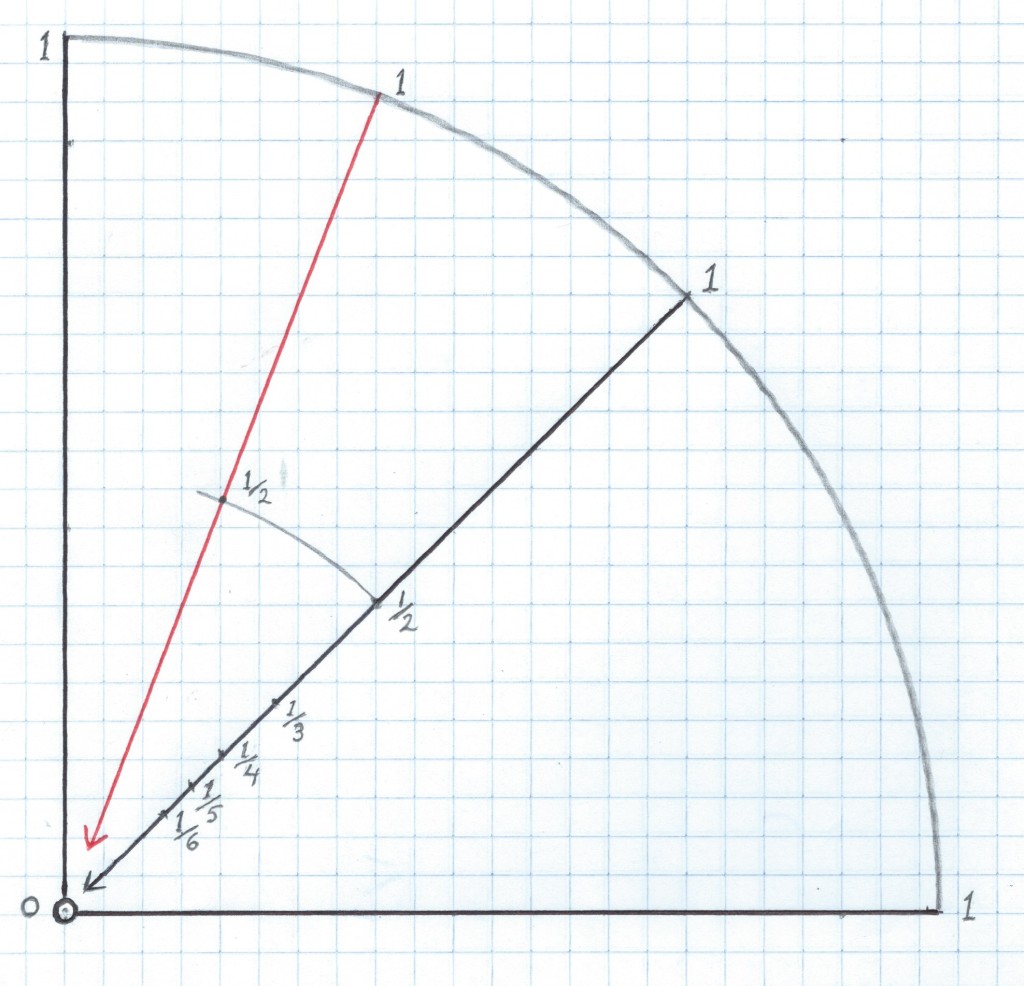
Adapted by this author from Lakoff and Nunez (2000), pg. 171, depicting the “inverse geometry” version of the BMI. Vectors converge inwards from 1 towards the infinitesimal limit of 0.
In this graphic, you have vectors starting at one from different angles and converging towards the center at zero. In this geometrical layout, the vectors reach infinity when they all arrive at the same place: zero. The closer they get to infinity, they closer they come to merging.
Now let’s take this presentation off the cartesian plane and amplify it.

As you spiral in closer and closer to the center, distances become infinitesimal. Getting back out is a different matter — it cannot be done with a vector, but must emerge through “hyperbolic geometry.” For an explanation of this, click here.
If you make the two-dimensional cartesian plane into a three-dimensional “funnel”, where the increasingly infinitesimal quantities “drop” into a “bottomless pit”, you get an image like the one on the left. As the vectors go further and further “down”, they become increasingly parallel. In this manner they become subject to the mathematical theory that parallel lines converge at infinity.
If we go even further to imagine a four-dimensional model, we can picture the curvature of time twisting the funneling parallel lines into an ever increasingly twisted coil, where each newly emergent coil takes up less and less real space, approaching the point of “singularity.”

Black Holes generating gravitational waves that bend space and time. Events such as the merging of black holes make the gravitational waves more pronounced for our new sensing devices to detect.
This theoretical singularity has unknown qualities due to its inaccessibility (e.g. the question of black holes, what might exist beyond their “event horizons”, and the fact that we cannot access any information beyond the event horizon because not even light can escape. This makes it feasible to consider the possibility that the center of a black hole is a “wormhole” into another dimension or part of the universe inaccessible to us. And if the centers of black holes operate outside of the laws of space and time, who is to say that these centers are not all the same porthole to another dimension of reality? The fact that we keep finding more and more massive black holes raises the question of what really is “normal” physics (link). We are also getting closer and closer to obtaining information about the first second after the “big bang” due to new tools for hearing the sound of “gravitational waves” that spread out from black holes, with the possibility that we can learn more what it means that the normal laws of physics no longer apply at the event horizon (link).
Indeed, weird aspects of the universe such as “entanglement” and “non-locality” suggest the possibility that “Entangled links might even create a kind of secret tunnel between the inside and the outside of a black hole.” (Award-winning science journalist George Musser in  Spooky Action at a Distance, Scientific American, 2015, pg. 42.)
Spooky Action at a Distance, Scientific American, 2015, pg. 42.)
Of course, this is all speculation. But it is speculation with a tantalizing amount of increasing evidence to suggest it.
But let us consider what math has to show us about the ontological question. Zero and Infinity are not properly numbers, they are numerical limits. Numbers are quantities; zero and infinity are quantitative limits. But as mathematical concepts, zero and infinity have different qualities other than being limits on real numbers. Zero can be used in applied mathematical calculations (addition, subtraction, multiplication). But when it comes to dividing by zero, or doing any calculations with infinity, we are in the theoretical realm.
So let’s do a little theoretical batting practice and see where the game leads.
0 X 0 = 0
0 X 1 = 0
0/0 = 1 (principle of identity)
0 + 1 = 1
∞ X 0 = 0
∞ + 1 = ∞
∞ X 2 = ∞
∞/∞ = 1 (principle of identity)
n/n = 1
∞ – n = ∞ (n = any positive real number less than infinity)
∞/n = ∞ (n = any positive real number less than infinity)
Now for a mathematical conundrum: What does n/0=?
Some say the answer is undefined. It is like saying you have 8 cookies to divide among zero children — how many cookies does each child get?
Others say the answer is not an applied mathematics answer. If we approach the question in terms of approaching limits, we see that as the numerator increases and the denominator decreases, the result increases toward infinity.
1,000,000,000,000 / .000,000,000,001 = a trillion divided by a trillionth (you do the math!)
So if the denominator is zero, and if the numerator is any positive real number or its fraction (even a trillionth!), then the answer is infinity (i.e. n / 0 = ∞).
A rejoinder is that if
n / 0 = ∞,
then
∞ X 0 = n
But how can ∞ X 0 equal any positive real number or its fraction? Doesn’t there have to be only one answer to a “specific” calculation?
But as we have seen, the concept of infinity is many-faceted. If ∞ + 1 = ∞ and ∞ – 1 = ∞ and ∞ X n = ∞ and ∞ / n = ∞ , then the results could depend on which infinity we mean.
This is what you get when you conflate quantities and qualities. This is why I think it is 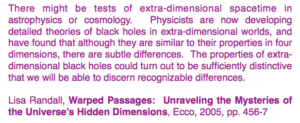 mathematically valid to say that between existence and nonexistence there is an infinite qualitative difference. Neither quantum foam nor any other “next to nothing” is a valid substitute for absolute nothingness.
mathematically valid to say that between existence and nonexistence there is an infinite qualitative difference. Neither quantum foam nor any other “next to nothing” is a valid substitute for absolute nothingness.
Matter and Spirit: Unity, Duality, Polarity
The fact that we humans beings, who are ourselves mere collections of fundamental particles of nature, have been able to come this close to an understanding of the laws governing us and our universe is a great triumph. — Stephen Hawking, “The Origin of the Universe”, 4/16/13
The increasing pace of scientific breakthroughs is startling. From the practical ability to “see” a galaxy 13.4 billion light years away to the theoretical ability to hypothesize how black holes might “leak,” and the composition of their event horizons (information storage?), it is dawning on us the extent to which many of the facets of reality are intelligible to the human mind. Certainly Stephen Hawking plays a significant role in developing this understanding, but the quote above reveals a flaw in his thinking.
If human beings are so close to understanding the laws that govern the universe, how is it that we are “mere collections of fundamental particles of nature”? The word “mere” stands out here. If “particles of nature” can understand themselves, there is something more to these particles than meets the conventional scientific eye.
In fact, some physicists are exploring possibilities along these lines. What does it mean that matter and energy can become alive and conscious, capable of reproducing and inventing? Could it be that matter and energy are by their very nature fertile and creative?
The following link is to the work of physicist Jeremy England (link) who is exploring the second law of thermodynamics as it might operate in an open system. In a closed system, entropy is relatively uniform with everything cooling and disintegrating at even rates. But in an open system, some areas will vary. England’s perspective (as I understand it) is that energy will by nature coalesce up to a certain threshold, and then seek the most efficient means of dispersing excess energy. England proposes that reproduction is the most efficient way to dissipate the largest amount of energy. Most women may have questions about this idea (how efficient was that C-section?), but since when have women’s questions inhibited science?
None-the-less, to the extent that I am a natural spiritualist, this is it. If matter is by nature spiritual, then the supernatural is immanent to nature. But if this means that spirituality comes naturally, it still requires effort, openness, gratitude, and a tolerance for ambiguity.
Matter and Consciousness
Nobody knows how to explain consciousness, neither what it is or how it has come about. The strict materialists believe that consciousness is an illusion produced by the activities of the physical brain, but as we have seen repeatedly, this explanation does not match our experience.
Dr. Penny Sartori, a former Emergency Room nurse and now a researcher in Near Death Experiences, presents a different theory of consciousness (Discovery News, Oct. 9, 2014):
“I think our understanding of consciousness is flawed,” [Dr. Penny] Sartori said. “Science has believed it’s a byproduct of the brain, but I don’t think it is. I think the brain acts as a filter and sometimes screens out consciousness. There are times in our life when the filter becomes dysfunctional and we experience a hyper state of consciousness.” (For a video of a talk by Sartori, click here.)
Another researcher on near-death-experiences comes to a similar conclusion:
After doing more than fifty years of professional work with consciousness now, one of the things that has been really interesting to me is that it’s become more and more clear that there is an aspect of consciousness that appears to transcend physical or material reality. At the same time it’s also clear to me that a lot of our ordinary consciousness is very dependent on being shaped by the nature of our bodies, or at least by our brains. Clearly, that shaping is completely gone from one’s reality after death. [An Interview with Charles Tart, in Frontiers of Psychedelic Consciousness, by David Jay Brown (Park Street Press, 2015) pg. 191.]
Research on psychedelic drugs is coming to similar conclusions. Two write-ups show that psilocybin (link) and LSD (link) reduce the activities of the brain areas associated with our sense of self and increase activities of the brain areas that make connections between perceptions. The result is an experience of the interconnectedness of the world and our sense of belonging to the world without separation. William Richards, a clinical psychologist at John Hopkins Bayview Medical Center, summarizes his 25 years of research on psychedelics in his recent book, Sacred Knowledge: Psychedelics and Religious Experiences (Columbia University, 2016). In the preface he writes of his first clinical trial on psilocybin. The research protocol suggested that the experience would unearth otherwise forgotten childhood memories, but instead he experiences the following:
To my utter amazement, I soon discovered in my visual field the emergence of an exquisitely beautiful, multidimensional network of intricate, neon-like geometric patterns, drawing my attention ever more deeply within. I could see this display with open eyes, but found that hwe I closed my eyes it was even more vivid and sharply focused. I recognized life within the undulating designs and began to feel as though I somehow could enter into the energy flowing within them. Soon I felt immersed in incredibly detailed imagery best described as Islamic architecture and Arabic script, about which I knew nothing. Then (forgive the poetic license), I seemed to fully become the multidimensional patterns or to lose my usual identity within them as the eternal brilliance of mystical consciousness manifested itself. Suddenly this consciousness was experienced as outside of time, a pinnacle from which history could be viewed. My awareness was flooded with love, beauty, and peace beyond anything I ever had known or wildly imagined to be possible. “Awe,” “Glory,” and “Gratitude” were the only words that remained relevant. (Preface, pg. xix)
Richards wrote down some notes during this experience, realizing that the fleeting quality of it may not allow him to remember as well as he thought he should at the time. Notably, what he wrote was “Reality is. It is perhaps not important what one thinks about it!” This experience has the same hallmarks of spiritual unity and fragility that we found with the “intuition of being” and related experiences (see Sprit Formation in the Research Findings section here).
This suggests that normal consciousness involves a reduction in the sensory experience so that our consciousness can serve our ego and its essential tasks. What mystical experiences, near death experiences, and psychedelic experiences do is to “lift the veil” of our brain’s active reduction of consciousness.

British researchers found significant differences in functional connectivity between a normal brain (left) and a brain on psilocybin (right).
One of the most fascinating accounts of a near death experience is in the TED Talk given by Dr. Jill Bolte Taylor, a brain scientist who had a near deadly stroke. (click here) She details her out-of-body experience vividly.
Prayer and meditation can produce similar results. Neurologists are now studying the brain waves of praying Carmelite nuns and meditating Buddhist monks, finding a decrease in beta waves and an increase in theta waves — see The Spiritual Brain: A Neuroscientist’s Case for the Existence of the Soul by Mario Beauregard (Norton 2007, pg. 265). Beauregard’s method for getting the brain scans during prayer is interesting: he has the nuns remember a mystical experience with their eyes closed, and it turns out this activates the brain in a way similar to the original mystical experience. He points out that if the nuns were faking the experience, the effort to do so would create beta waves, not theta waves!
Lynn Margulis and her son Dorion Sagan (son of Karl Sagan) hold a similar view when they reference Emily Dickinson’s poem on the front page of their book Dazzle Gradually (Chelsea Green, 2007):
This is what double helix dynamics is about — tracing how we are dazzled gradually. (In their article “The Uncut Self”, Margulis and Sagan make a case that it is the self that is an illusion, not reality and consciousness. Sounds pretty mystical to me!)
Anyway, I don’t think the materialists (e.g. Dawkins) or the mentalists (e.g. Pinker) have any credible rebuttal to these findings. The findings don’t “prove” anything, but serve as testimony that the depictions offered by materialists and mentalists are ridiculous. So, along with Klaus Riegel, we can shout: “Dialectic psychologists unite! You have nothing to lose but the respect of vulgar mechanists and pretentious mentalists; you will win a world, a changing world created by ever-changing human beings.”
For more on this subject, and to read my own personal and totally speculative Theory of Everything (ToE), go to this link, The Fifth Dimension.
DNA & The Double Helix
There are the sayings about the forest and the trees: can’t see the forest for the trees, and can’t see the trees for the forest (OK, I made that last one up, but there are people who think so generally that they can’t identify examples to back their perspective). This metaphor leaves out an important relation between the forest and the trees: the patterns of the trees informs us about the nature of the forest, and the pattern of the forests tells us something about the nature of the trees (e.g. how they got established in the valley or on the hillside, etc.).
In this section I am going to outline the parallels between two women scientists and their methods: Rosalind Franklin, who first x-ray photographed a DNA strand with sufficient clarity to be able to detect the pattern as double-helix. The other is Jane Loevinger, who used Harry Stack Sullivan’s and Erik Erikson’s models as general outlines in order to detail ego development by using her method of x-ray photography, the sentence completion method (e.g., “I feel anxious when ______”, fill in the blank). This method gave Loevinger and her research assistants copious “snapshots” of ego development, with the result of ever refining the designs and dynamics of human development.
Rosalind Franklin was close to endorsing her findings as representing a double-helix structure when James Watson, who had stolen Franklin’s work, made the case that DNA was double-helix. So I am playing the role of James Watson to Jane Loevinger, saying that her findings, in conjunction with the other research findings outlined in my grid, reveal a double-helix structure and dynamic (hopefully I am more of a gentleman in my relation to Loevinger, neither demeaning her personally nor taking credit for her work). I think that Loevinger, with more time, would have gotten there herself since she understood that development includes both conscious and sub-conscious strands (both Sullivan and Erikson had a keen sense of the sub-conscious).
There appear to be other parallels between how DNA operates and how the double-helix model operates. Whereas the products of DNA/RNA, amino acids and proteins, are insulators against electricity, DNA itself is a conductor of electricity. The is crucial to the survival of DNA because this conductivity allows DNA to repair itself. If say radioactivity knocks out an electron in the DNA strand, then the DNA imports an electron from its environment through the end of the strand, and zips it right into the missing spot. Without this restorative function, DNA slowly unravels (like the split end of a hair), and aging accelerates.
In the same way, if our minds and souls are closed to outside energy and information, our brains and hearts atrophy. We need to keep an open mind and open heart sufficient to keep our cognitive and emotional capacities healthy. But not so open that we leak all over the place! It can be healthy to be vulnerable towards those who have earned our trust, but it is not healthy to throw caution to the wind and fail to defend ourselves from those who do not mean well by us.
These are some reasons that I have found the double-helix metaphor so rich. If any readers have others thoughts on potential parallels, please let us know!
%%%%%%%%%%%%%%%%%%%%%%%%%%%%%%%%%%%%%%%%%%%%%%%%%%%%%%%%%%%%%%%%%%%%%%%%%%%%%%%%%%%%%%%%%%%%%%%%%%%%%%%%%%%%
Below the Salt: Tid-bits in response to reader questions
P.S.: Turtles All the Way Down
A depiction of the “infinite regress” resulting from the Deist theology of God as the biggest force in the universe — you can always postulate a bigger force necessary to move the “biggest”, resulting in “turtles all the way down.” (see post below by Most Expensive Jewelry)
Wikipedia link here.
Originally the metaphor assumed a flat earth and the turtles held up the ground. With a spherical earth, the whole image goes topsy-turvy.

